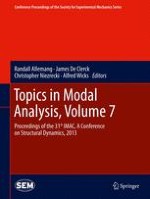2014 | OriginalPaper | Buchkapitel
24. Replicating Aerodynamic Excitation in the Laboratory
verfasst von : P. M. Daborn, P. R. Ind, D. J. Ewins
Erschienen in: Topics in Modal Analysis, Volume 7
Verlag: Springer New York
Aktivieren Sie unsere intelligente Suche, um passende Fachinhalte oder Patente zu finden.
Wählen Sie Textabschnitte aus um mit Künstlicher Intelligenz passenden Patente zu finden. powered by
Markieren Sie Textabschnitte, um KI-gestützt weitere passende Inhalte zu finden. powered by
